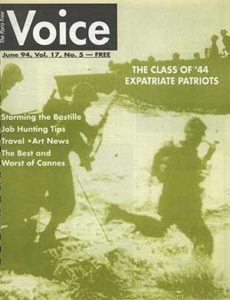“If someday you have a few months to spare, come to Barbary…you will feel the precious and exceptional influence of the sun, which gives everything a piercing life.” Just over 160 years ago, Eugène Delacroix left a wan Paris winter for a six-month adventure in North Africa. While few of us can jump up and follow his footsteps, following his brush strokes is an excellent alternative. Delacroix in Morocco – a gathering of his painted mementos – is on exhibit until January 15 at the Institut du Monde Arabe.
The Liberation of Paris Revisited
“Turn Paris into a pile of ruins. Defend it to the last man,” were Hilter’s orders to the German Commander of Greater Paris in mid-August 1944. Adolf Hitler was smelling imminent defeat, and he intended taking the city of Paris and its people down with him. Continue reading “The Liberation of Paris Revisited”
Nadar, World’s First Celebrity Photographer
As one of the earliest professional portrait photographers (and to this day one of the best), Felix Tournachon, known as Nadar, endowed his generation with perpetual faces, enabling us to look into the eyes of history. History currently looks back from the walls of the Musée d’Orsay, where nearly 100 Nadar portraits make up a picture gallery of the Second Empire.
Continue reading “Nadar, World’s First Celebrity Photographer”
First Years of French Impressionism
“The true artists are those who take their epoch at exactly the point to which it has been carried by the preceding ages. To retreat is to do nothing, is to work without result, is to have neither understood nor profited from the lessons of the past.”
Remembering Normandy 1944
 As May slips into June, the beaches and apple orchards of Normandy will play host to a kinder, gentler invasion than the Big One five decades ago that landed it a rock-solid place in the pages of world history. This time around, the tourists are coming, and the Normans are prepared for them: over 600 events are planned to commemorate the liberation of a war-ravaged Europe, which struck the shore like lightning on the morning of June 6, 1944.
As May slips into June, the beaches and apple orchards of Normandy will play host to a kinder, gentler invasion than the Big One five decades ago that landed it a rock-solid place in the pages of world history. This time around, the tourists are coming, and the Normans are prepared for them: over 600 events are planned to commemorate the liberation of a war-ravaged Europe, which struck the shore like lightning on the morning of June 6, 1944.
Dining out in Paris with the Lizard King
Jim Morrison ate his last meal at Le Beautreillis, a little restaurant near the Place de la Bastille in Paris. What killed him remains murky but the authorities ruled out dinner, so cult followers have flocked to the place ever since. A shrine it may be, but the restaurant serves up more than warmed-over memories. The blini are terrific. And so is the host, a genial Croatian named Verian. He bought the place two years ago, serves honest Slav food, and says he doesn’t much care about the legend of “Jeem.” But his black leather pants tell a different story. So do the the luvmobile up the street and the heaps of Morrison memorabilia threatening to avalanche the restaurant’s side room. But we’re getting ahead of ourselves. . .
Paris Fashion… a Yen for Style
Grunge, pauperism, minimalism, hip hop and recoup’ (recycled salvaged looks), the styles most popular among young people today, all have one thing in common: their roots can be traced to the Japanese movement of the 1980s. With their strong, innovative shapes, high-tech fabrics and radically different fashion philosophy, Japan’s leading avant-garde designers are responsible for shaping the way an entire generation perceives modern style today.
Mavis Gallant… “I Live in French”
Misshapen beads of the unexpected snow dappled the floor around Mavis Gallant’s chair in the main room of the Select. She had shed her heavy coat and umbrella, and had ordered a coffee when a casually dressed young man approached from behind and tapped her shoulder apologetically.
Brassai Walking on the Wild Side
Every so often back in the ’30s, dark stretches of nighttime Paris would be lit by a sulfurous flash. Brassai was at work, taking pictures in which conventional beauty held little appeal. Like Toulouse-Lautrec, he was a well-born, highly trained visual artist who found inspiration in the down and dirty.
Camille Claudel Revisited
Why would the Musée Rodin have another Camille Claudel show just seven years after they hosted her retrospective? Consider what followed on the heels of that exhibition – biographies, TV programs, traveling shows of Claudel’s work in the U.S., Japan and Germany, a 1988 film by Bruno Nuytten (now on videocassette), even a book of poetry written in Claudel’s voice and reprinted five times by Louisiana State University Press. Add to that the countless articles in which the Claudel/Rodin dispute has been tossed about by critics and scholars of nearly every persuasion. Continue reading “Camille Claudel Revisited”
Screaming Ice Cream in French
Two little things happened recently in Paris that peaked my American glands: 1) Haagen Dazs infiltrated my local Prisunic and 2) I “dined” for the first time at Pizza Hut on the rue de Rivoli. Seemingly innocuous events, they nonetheless lent themselves to larger cultural scrutiny and psycho-existential re-positioning. The entrepreneur in me spotted the need for a culinary guide for the French, on American Popular Eats. The purist in me wretched. The menu of details before me read with the cultural differences of our two lands. Continue reading “Screaming Ice Cream in French”

